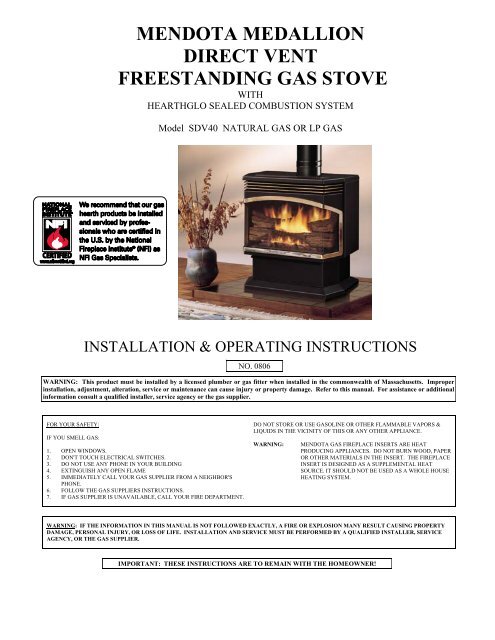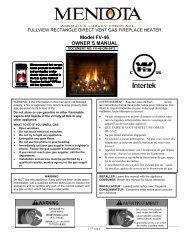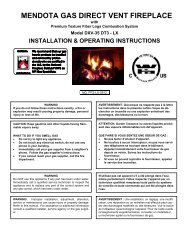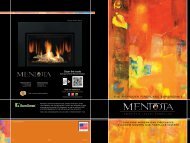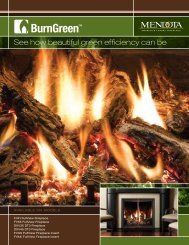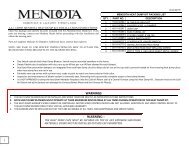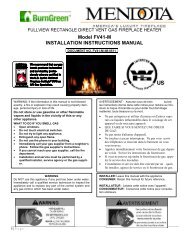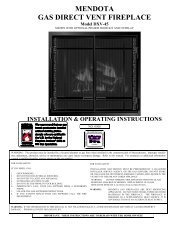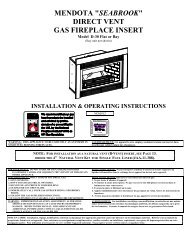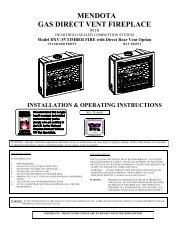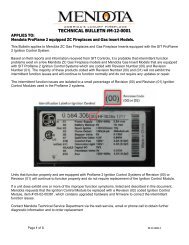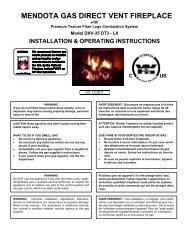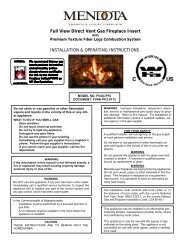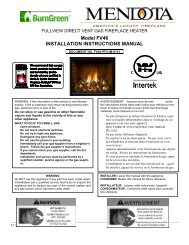Mendota Medallion Free-Standing Gas Stove Model SDV-40
Mendota Medallion Free-Standing Gas Stove Model SDV-40
Mendota Medallion Free-Standing Gas Stove Model SDV-40
- No tags were found...
You also want an ePaper? Increase the reach of your titles
YUMPU automatically turns print PDFs into web optimized ePapers that Google loves.
MENDOTA MEDALLIONDIRECT VENTFREESTANDING GAS STOVEWITHHEARTHGLO SEALED COMBUSTION SYSTEM<strong>Model</strong> <strong>SDV</strong><strong>40</strong> NATURAL GAS OR LP GASINSTALLATION & OPERATING INSTRUCTIONSNO. 0806WARNING: This product must be installed by a licensed plumber or gas fitter when installed in the commonwealth of Massachusetts. Improperinstallation, adjustment, alteration, service or maintenance can cause injury or property damage. Refer to this manual. For assistance or additionalinformation consult a qualified installer, service agency or the gas supplier.FOR YOUR SAFETY:IF YOU SMELL GAS:1. OPEN WINDOWS.2. DON'T TOUCH ELECTRICAL SWITCHES.3. DO NOT USE ANY PHONE IN YOUR BUILDING4. EXTINGUISH ANY OPEN FLAME5. IMMEDIATELY CALL YOUR GAS SUPPLIER FROM A NEIGHBOR'SPHONE.6. FOLLOW THE GAS SUPPLIERS INSTRUCTIONS.7. IF GAS SUPPLIER IS UNAVAILABLE, CALL YOUR FIRE DEPARTMENT.DO NOT STORE OR USE GASOLINE OR OTHER FLAMMABLE VAPORS &LIQUIDS IN THE VICINITY OF THIS OR ANY OTHER APPLIANCE.WARNING:MENDOTA GAS FIREPLACE INSERTS ARE HEATPRODUCING APPLIANCES. DO NOT BURN WOOD, PAPEROR OTHER MATERIALS IN THE INSERT. THE FIREPLACEINSERT IS DESIGNED AS A SUPPLEMENTAL HEATSOURCE. IT SHOULD NOT BE USED AS A WHOLE HOUSEHEATING SYSTEM.WARNING: IF THE INFORMATION IN THIS MANUAL IS NOT FOLLOWED EXACTLY, A FIRE OR EXPLOSION MANY RESULT CAUSING PROPERTYDAMAGE, PERSONAL INJURY, OR LOSS OF LIFE. INSTALLATION AND SERVICE MUST BE PERFORMED BY A QUALIFIED INSTALLER, SERVICEAGENCY, OR THE GAS SUPPLIER.IMPORTANT: THESE INSTRUCTIONS ARE TO REMAIN WITH THE HOMEOWNER!
"LABEL REPRESENTATION"WARNOCKHERSEYGAS LOGOLISTED GAS-FIRED DIRECT VENT ROOM HEATERPOÊLE AU GAZ HOMOLOGUE’, A AÉRATION DIRECTEMODEL: <strong>SDV</strong><strong>40</strong> MEDALLIONCERTIFIED FOR CANADAHOMOLOGUÉ POUR LE CANADAAlso for use in mobile (manufactured) homes after first sale of home. Convenant également pour installations dans des maisons mobiles.Tested to (Testé aux normes) ANSI Z21.11.1-1993, CAN1-2.1-M89, CAN/CGA 2.17-M91, ANSI Z21.50-1996 and CAN/CGA 2.17--M91,ANSI Z21.50-1996-CSA 2.22-M96, UL307B-1996._________________________________________________WARNING: Improper installation, adjustment, alteration, service or maintenance can cause property damage, personal injury, or loss of life. Refer to the owner's information manualprovided with this appliance. Installation and service must be performed by a qualified installer, service agency or the gas supplier. Use only glass assemblies certified for use with thisappliance. Do not operate with glass panel(s) removed, cracked, or broken.MISE EN GARDE: Installation, réglage, modification, entretien ou depannage non appropriés pourront causer des blessures ou des dommages materiels. Réferéz-vous au manuel duproprietaire fourni avac cet appariel. Pour assistance ou renseignements complémentaires, veuillez consulter un installateur expérimenté, une agence dé depannage/entreitien ou cotrecompagnie gaziére. Pour utilisation avec les portes en verre certifiée l'appareil suelement. Ne pas opérer avec le verriére enlever, craquelure, brise.NOT FOR USE WITH SOLID FUEL (NE DOIT PASÉ UTILISÉ AVEC UN COMBUSIBLE SOLIDE)NATURAL GAS(Gaz Naturel)PROPANE GAS(Gaz de petrole liquefie (GPL))Input Rating (Btu/hr) 0-1370 m (Entrée nominale) <strong>40</strong>,000 35,000Min. Input Rating (Btu/hr) 0-1370 m (Mininale Entrée nominale) 27,800 26,100Orifice (DMS) )-1370 m (Orifice) 30 50Maximum output (Btu/hr) (Sortie maximale) 31,300 27,800Manifold Pressure (in w.c./kPa) (Pression au collecteur) 3.5/0.87 10.0/2.5Manifold Pressure, low (in w.c./kPa) Pression d'entree minimale) 1.7/0.42 3.6/0.90Minimum Inlet Pressure (in w.c./kPa) (Pression d'entrée minimale) 5.0/1.25 11.0/2.75_______________________________________________This appliance must be installed in accordance with local codes if any; If not, follow ANSI Z223.1 or CAN/CGA-B149. Mobile (Mfd.) home installations must adhere to Title 24 CFR,Part 3280, or CSA Z2<strong>40</strong>.4.Cet appareil sera installé conformémént avec les codes locaux, le cas écheant. Si aucun code n'existe, suivez la norme ANSI Z223.1 ou la norme CAN/CGA (ACNOR)-B149._______________________________________________MINIMUM CLEARANCES FROM COMBUSTIBLE CONSTRUCTIONUnit to sidewall 10 in. (255 mm) Unit top to ceiling 39 in. (990 mm.)Unit to backwall 2 in. (50 mm.) Outlet vent to enclosure top 4 in. (105 mm.)CAUTION: Hot whil in operation. Do not touch. Keep children, clothing, furniture, and flammable liquids or vapors away. ATTENTION: L'appareil est chaud lorsqu'il fonctionne.Ne pas toucher l'appareil. Survieller les enfants. Garder les vétements, les meubles, l'essence ou autres liquides a capeur inflammables loin de l'appareil._______________________________________________Electrical Rating (Courant nominal): 120 volts 60 Hz Less than 1 Ampere_______________________________________________Manufactured by (Fabriqué par):JOHNSON GAS APPLIANCECEDAR RAPIDS, IOWADO NOT REMOVE OR COVER THIS LABELVEILLEZ Á NE JAMAIS ENLEVER NI DISSIMULER CETTE ÉTIQUETTEWH# __________________TEST STANDARD CERTIFICATION<strong>Gas</strong> appliances must be tested and certified by a nationally recognized testing and certification laboratory to ANSI (American National Standards Institute) gasappliance safety standards.The <strong>Mendota</strong> <strong>Gas</strong> <strong>Stove</strong> has been tested and certified by Intertek Testing Services, 8431 Murphy Drive, Middleton, Wisconsin 53562 to ANSI1 Z21.11.1-1993"Vented Room Heaters"; CAN 2.1-M89 "Vented Room Heaters"; CAN/CGA 1.17-M91 "<strong>Gas</strong>-Fired Appliances for use at high altitudes"; ANSI Z21.50-1996,CGA 2.22-M96 "Vented <strong>Gas</strong> Fireplaces; and UL307B-1987 "<strong>Gas</strong> Burning Heating Appliances for mobile homes, not for use with solid fuel.The <strong>Mendota</strong> <strong>Gas</strong> <strong>Stove</strong> has met all necessary AGA/ANSI Standards and is fully certified for installation in any community.MAIN GAS CONTROL INSTALLATION1. DO NOT USE THIS STOVE IF ANY PART HAS BEEN UNDER WATER OR EXPOSED TO MOISTURE CORROSION. IMMEDIATELY CALL AQUALIFIED SERVICE TECHNICIAN TO INSPECT THE STOVE AND REPLACE ANY PART OF THE CONTROL SYSTEM AND ANY GASCONTROL WHICH HAS BEEN UNDER WATER.2. DO NOT insert any object other than suitable pipe or tubing in the inlet or outlet of the main gas control. Internal damage may occur and result in ahazardous condition.3. DO NOT connect the <strong>Stove</strong> before pressure testing gas piping and checking for gas leaks. Damage may result causing gas leakage.4. DO NOT grip gas control body with a pipe wrench or vise. Damage may result causing gas leakage. Use inlet or outlet bosses, or special body wrench.5. DO NOT use "off/on/pilot" gas knob to adjust gas flow.6. Leak test with a soap solution with main burner "ON".3
LOCATING THE STOVESAFETY AND STRUCTURAL CONCERNS:The <strong>Mendota</strong> Direct Vent <strong>Free</strong>standing <strong>Stove</strong> must be installed and serviced by a qualified <strong>Mendota</strong> approved serviceperson. The <strong>Mendota</strong> Direct Vent <strong>Free</strong>standing <strong>Stove</strong> may be placed within 2" of a rear wall, within 10" of side walls,within 1 1/2" of corner walls and 39" below an alcove ceiling [See Figure 2: Specifications & Clearances on page5]. The <strong>Stove</strong> can be installed on any rigid floor construction. A metal or wood floor protector extending the fullwidth and depth of the <strong>Stove</strong> MUST be used when the <strong>Stove</strong> is installed on carpet, vinyl or any combustible surfaceother than wood flooring.The stove is equipped with a safety control system designed to protect against improper venting of combustionproducts.VENTING REQUIREMENTS:Use only approved direct venting kits when installing your stove. Closely follow venting directions andrequirements (see FLUE VENTING INSTRUCTIONS starting on page 8). Observe the restriction relating to ventposition on exterior of home (see Exterior Vent Locations on page 7).HEATING PERFORMANCE:The <strong>Mendota</strong> Direct Vent <strong>Free</strong>standing <strong>Stove</strong> is a true, high efficiency gas heater. With its heat input of <strong>40</strong>,000(35,000 L.P.) BTUH the <strong>Mendota</strong> <strong>Stove</strong> will heat a large area of your home if situated to maximize heat circulation.NOTE: The <strong>Stove</strong> is a major source of supplemental heat.Air movement options for maximizing heat circulation which can be considered are through-the-wall grills or floorgrills, or the continuous operation of central heating blowers or ceiling fans.The most efficient and successful method for overall heat distribution is a ceiling fan - we recommend this method for the ownerwho wishes to maximize hot air distribution and efficient utilization of heat.The heat input of the <strong>Stove</strong> can be reduced by slowly turning the Hi/Lo temperature knob on the front of the gas valvecounterclockwise from "Hi" to "Lo". The blower can also be turned down or off.Figure 1: Main <strong>Gas</strong> ValveELECTRICAL REQUIREMENTS:The blower requires a 115 volt electrical service supplied at the <strong>Stove</strong> location at the time of installation.The blower must be electrically grounded in accordance with local codes or in the absence of local codes, with the NationalElectric Code ANSI/NFPA 70-1987 (CSA C22.1-Canadian Electrical Code) or most current edition. The blower is equippedwith a three-prong (grounding) plug for your protection against shock hazard and should be plugged directly into a properlygrounded three-prong receptacle. DO NOT CUT OR REMOVE THE GROUNDING PRONG FROM THIS PLUG!If an optional thermostat is being used, thermostat wire should be run from desired thermostat location (or "on/off" switch) to theterminals located on back of pedestal--See optional thermostat installation section [See page 22]. An inlet hole is provided onthe rear of the pedestal for gas connection.4
MENDOTA MEDALLIONMENDOTA DIRECT VENT FREESTANDING GAS STOVESPECIFICATIONS & CLEARANCESFigure 2: Specifications & Clearances5
INSTALLATION INSTRUCTIONSThe <strong>Mendota</strong> <strong>Stove</strong>s must be installed in accordance with local codes, if any, if not, follow the current edition ofANSI.Z223.1 (US Installation) or CAN1-B149 (Canadian Installations). For mobile home installation, install per themanufactured home construction and safety standard, title 24 CFR, part #3280 (U.S.) or CAN/CSA Z2<strong>40</strong> MH (Canada).The <strong>SDV</strong> <strong>Stove</strong> must be installed by a qualified <strong>Mendota</strong> approved service person.1. Carefully unpack the <strong>Stove</strong>. Inspect packaging for loose parts. You should find a trivet plate.2. Position <strong>Stove</strong> in its final desired location [See Page 4]. Be sure to maintain minimum clearances tocombustibles. Check to be sure all venting restrictions and requirements are being followed (See Pg. 7-16). Circulating room air enters the fan through the back of the pedestal. Carefully check to be certainthat nothing blocks air entry to this area. Lower front door must also be free to open easily for inspectionand servicing of the burner system.CAUTION: When the <strong>Stove</strong> is installed directly on carpeting, vinyl or other combustible material otherthan wood flooring, the <strong>Stove</strong> MUST be installed on a metal or wood protection panel extending thefull width and depth of the <strong>Stove</strong>.3. Remove front glass window/door by releasing the 4 turn latches behind side doors (rotate latchescounterclock-wise and pull outward) and carefully sliding glass door forward.4. You are now ready to hook up the gas supply. Be sure gas plumbing instructions [page 16 & 17] andall state and local codes are carefully followed.5. Use approved flexible gas connection or rigid piping [depending on state & local codes] to attachburner to gas supply. Be sure correct size IPT black iron gas supply line is used [See Table 1: <strong>Gas</strong>Supply Line Sizing on page 16]. CAREFULLY CHECK FOR GAS LEAKS.6. Connect gas supply line to 3/8" inlet nipple on the rear of the stove pedestal. (See FIGURE 6: PipingDetail, page 16.)7. To use the blower there must be a 115 Volt electricity source within 5' of <strong>Stove</strong>. (See Pg. 4 & Pg. 26)IMPORTANT: Any safety screen, guard, glass, grill, pressure relief cap, etc. removed for servicing afireplace/room heater must be replaced prior to operating the fireplace/room heater.BLOWER OPERATIONThe <strong>Mendota</strong> <strong>SDV</strong><strong>40</strong> <strong>Stove</strong> is designed so the blower operates automatically when main burner is on and rheostat is “on”.The blower output can be regulated with the rheostat (included). NOTE: There will be a time delay in blower operationduring "heat-up" (approx. 1/2 hour) and extended blower operation during "cool-down" of unit. (approx. 1/2 hour)OPERATION DURING POWER OUTAGESThe stove is designed to operate during power outages.EXTERIOR VENT LOCATIONS AND RESTRICTIONS6
Figure 3: Exterior Vent LocationsA =B =∨ - Vent Terminal ∧ - Air Supply Inlet ≡ - Area where terminal is not permittedClearance above grade, veranda, porch, deck, orbalcony (*12 inches (30 cm) minimum)Clearance to window or door that may be opened(*12 inches (30 cm) minimum)C = Clearance to permanently closed window (minimum 12inches (30 cm) recommended to prevent condensationon window)D =E =Vertical clearance to ventilated soffit located above theterminal from the center-line of the terminal (18 inches(46 cm) minimum)Clearance to unventilated soffit (12 inches (30 cm)minimum)H =I =J =*Not to be installed above a meter/regulator assemblywithin 3 feet (90 cm) horizontally from the center-line ofthe regulatorClearance to service regulator vent outlet (*6 feet (1.8m)minimum)Clearance to non-mechanical air supply inlet to building orthe combustion air inlet to any other appliance.(*12 inches (30 cm) minimum)K = Clearance to a mechanical air supply inlet (*6 feet (1.8 m)minimum)L =† Clearance above paved side-walk or a paved drivewaylocated on public property (*7 feet (2.1 m) minimum)F = Clearance to outside corner - 6 inches (15 cm) M = Clearance under veranda, porch, deck, or balcony (*12inches (30 cm) minimum ‡)G = Clearance to inside corner - 12 inches (30 cm)† A vent shall not terminate directly above a side-walk or paved driveway which is located between two singlefamily dwellings and serves both dwellings.‡ Only permitted if veranda, porch, deck, or balcony, is fully open on a minimum of 2 sides beneath the floor.* As specified in CGA B1:19 Installation Codes (1991). Note: Local codes or regulations may require differentclearances.7
FLUE VENTING INSTRUCTIONSThe <strong>Mendota</strong> <strong>Stove</strong> must be vented using the <strong>Mendota</strong>/Dura-Vent venting system. All warranties will be voidedand serious fire, health or other safety hazards may result from any of the following actions: Instal-lation of anydamaged component; unauthorized modification of vent system; installation of stove and vent system byunauthorized personnel; and vent system installation of any components not manufactured or approved by SimpsonDura-Vent or <strong>Mendota</strong>; failure to meet all clearance requirements; failure to properly twist-lock all components.Consult local building codes before beginning the installation.WARNINGAlways maintain required clearances (air spaces) to combustibles to prevent a fire hazard. Do not fill air spaces withinsulation. Check installation instructions for minimum clearance requirements between the outer walls of the ventpipe and nearby combustible surfaces. Be sure to check the vent termination clear-ance requirements from decks,windows, soffitts, gas regulators, air supply inlets, and public walkways, as specified in these installation instructionsand local building codes (See page 7).The gas appliance and vent system must be vented directly to the outside of the building, and never attached to achimney serving separate solid fuel or gas burner appliance. Each direct vent gas appliance must have its ownseparate vent system. Common vent systems are prohibited.Do not recess vent termination into a wall or siding.WE STRONGLY RECOMMEND THAT FIXED LENGTH PIPE SECTIONS BE USED IN PLACE OFTELESCOPING SECTIONS WHENEVER POSSIBLENote: When using Dura-vent DV pipe you must use a silicate stove masonry sealant [Millpak Sealant#65-06-00909] on all inner pipe joints. On the exterior (air intake) pipe joints, high temperature foiltape may be used instead of the masonry sealant. Contact your dealer to obtain this sealant material.DO NOT SEPARATE TELESCOPING SECTIONS. THEY MUST BE USED AS COMPLETEASSEMBLIES.SAFETY PRECAUTIONS FOR THE INSTALLER1. Wear gloves and safety glasses for protection.2. Exercise extreme caution when using ladders or on rooftops.3. Be aware of electrical wiring locations in walls and ceilings.COMPONENT "TWIST-LOCK" CONNECTION PROCEDUREDura-Vent pipe and fittings are designed with special twist-lock connections. Twist-lock procedure is as follows:four (4) indentations, located on the female ends of pipes and fittingsare designed to slide straight in to the male ends of the adjacent pipes and fittings, by orienting the four pipeidentifications so that they match and slide into the four entry slots on the male ends (Figure 4).Push the pipe sections completely together then twist-lock one sectionclockwise, approximately 1/4 turn until the two sections are fully locked.The female locking lugs will not be visible from the outside on the black pipeor fittings. They may be located by examining inside of the female ends.8Figure 4: Twist-LockPiping
VENTING COMPONENT INSTALLATION SEQUENCE AND PARTS LISTITEMDESCRIPTION6" RIGID VENT STACK (Black)9" RIGID VENT STACK (Black)1 12" RIGID VENT STACK PIPE (Galvanized))12" RIGID VENT STACK PIPE (Black)24" RIGID VENT STACK PIPE (Galvanized)24" RIGID VENT STACK PIPE (Black)36" RIGID VENT STACK PIPE (Galvanized)36" RIGID VENT STACK PIPE (Black)48" RIGID VENT STACK PIPE (Galvanized)48" RIGID VENT STACK PIPE (Black)11 - 14 5/8" ADJUSTABLE VENT PIPE (Black Only)2 90º ELBOW (Galvanized)90º ELBOW (Black)3 45º ELBOW (Galvanized)45º ELBOW (Black)4 ROUND CEILING SUPPORT BOX/WALL THIMBLE5 CATHEDRAL CEILING SUPPORT BOX6 SIDING STANDOFF7 HORIZONTAL TERMINATION VENT CAP8 FIRE STOP SPACER9 ATTIC INSULATION SHIELD10 FLASHING 0/12 THRU 6/12FLASHING 7/12 THRU 12/1211 STORM COLLAR12 VERTICAL TERMINATION VENT CAP13 SUPPORT BAND (WALL STRAP)HORIZONTAL TERMINATIONVERTICAL TERMINATIONIf adjustable – telescoping – pipe sections must be used, MILLPAK 2000° SILICATE STOVEMASONRY SEALANT (part #65-06-00909)* NOTE: DO NOT SEPARATE TELESCOPING SECTIONS.THEY MUST BE USED AS COMPLETE ASSEMBLIES.Figure 5: Flue Venting Components9
FLUE VENTING REQUIREMENTSThere are two basic types of venting system installationsA. HORIZONTAL THROUGH THE WALL TERMINATION1) Minimum rise2) Elevated riseB. VERTICAL THROUGH THE ROOF TERMINATION1) Through typical roof2) Through existing chimneyFigure 5: Minimum-Maximum Vent Requirements10
A-1 MINIMUM RISE THROUGH-THE-WALL VENTING:The minimum vertical rise for vent installation through the wall is 30" from the top of the stove to thecenterline of the 90º elbow. This distance can be achieved by using a 24" length of vent pipe between thestove collar and the elbow (see Figure 2: Specifications & Clearances, page 5). NOTE: We recommendalways using the most vertical rise the installation will allow. This maximizes efficiency and flameappearance. This is especially true for LP gas installations and for installations at higher altitudes.ALWAYS MAINTAIN 1 1/2 " CLEARANCES FROM VENT PIPE TO COMBUSTIBLES. Do not fillair spaces with insulation or other material.IMPORTANT: REFER TO DRAWINGS ON PAGES 9 & 10 WHILE FOLLOWING THESE INSTRUCTIONS.The <strong>Medallion</strong> <strong>Stove</strong> must be installed by a qualified <strong>Mendota</strong> approved service person.1. Position stove in desired location. See page 7 for guidelines on proper vent cap placement on theexterior of home. Check to determine if wall studs are in the way when venting system is attached. Ifthis is the case, you may want to adjust the stove location.2. Measure up 30" from top of <strong>Stove</strong> or 60 5/8" from finished floor. (See Figure 2: Specifications &Clearances, Page 5) and mark wall directly at the center of where the vent pipe will penetrate the wall.3. Cut and frame a 10" x 10" opening in the wall. The hole must be positioned so the vent system will runlevel or have a ¼ " rise AND be perpendicular to the wall. The height of the opening must be located tomeet all local and national building codes and not allow the termination to be easily blocked orobstructed. If wall being penetrated is non-combustible material, i.e. masonry block, brick, etc., a7-inch diameter hole is acceptable.4. Assemble the components to the stove adapter with pipe seams oriented toward the wall or floor - asmuch out of view as possible. Be sure all component connections are in their fully twist-locked, leaktight position. (See page 8, "TWIST LOCK CONNECTION PROCEDURE") Be sure Millpak 2000°sealant (#65-06-00909) is used on the inner pipe joints of all adjustable (telescoping) pipe sections.5.*NOTE: DO NOT SEPARATE TELESCOPING SECTIONS USE AS COMPLETE ASSEMBLIES5. The length of the horizontal piece that fits through the wall will be determined by the thickness ofthe wall. When installed, the end of the horizontal piece must be flush with the exterior wall of thehome. There MUST be a minimum of 1 1/2" air space clearance to combustibles from all vent pieces.6. Before connecting the horizontal run of vent pipe to the vent terminator, slide the black decorative wallthimble cover over the vent pipe on the inside of the wall.7. From the exterior of the home, slide the horizontal vent cap over the end of the horizontal pipe andtightly secure the cap to the wall with screws. Seal with a high quality caulking.NOTE: Do not recess vent termination cap into the wall or siding.11
A-2. ELEVATED RISE THROUGH-THE-WALL VENTINGThe maximum vertical rise is 15 ft. when used with a maximum horizontal run of 15 ft. For other ventingconfigurations within these maximum limits (see Figure 5, page 10).NOTE: The horizontal run of vent pipe must be level or have a ¼" rise for every 1' of run toward thetermination. Never allow the vent to run downward. This will cause high temperatures and thepossibility of a fire.USING OFFSETS AND RETURNS: A single 90º vertical-to-horizontal elbow is already calculated intothe allowable maximum 12' horizontal run. Each additional 90º elbow reduces the maximum horizontaldistance by 3'. Example: by using three total 90º elbows the maximum horizontal distance has beenreduced to 6 ft. (3 - 1 = 2 elbows x 3' = 6'; 12’ Max. - 6' of elbows = 6' of horizontal run). Note: 45ºelbows reduce the maximum horizontal distance by 1½ '. Always maintain the proper rise (6' for eachelbow used after the initial elbow) for the calculated total run when using elbows.SUPPORT: Horizontal runs of pipe will require one vent support for every 3 ft. of pipe.CAUTION: If a vertical-to-horizontal elbow is enclosed within a wall, floor or ceiling, a top air spaceclearance of 3" must be maintained.Be sure to maintain 1 1/2" air space clearances to any combustibles.IMPORTANT: REFER TO DRAWINGS ON PAGES 9 & 10 WHILE FOLLOWING THESE INSTRUCTIONS.The <strong>Medallion</strong> <strong>Stove</strong> must be installed by a qualified <strong>Mendota</strong> service person.1. Position stove in desired location. See page 7 for guidelines on proper vent cap placement on exteriorof home. Check to determine if wall studs are in the way when vent system is attached. If this is thecase you may want to adjust the stove location.2. Locate position where vent pipe will pass through any ceilings and will penetrate the outside wall.Since vent pipe sections "overlap" we suggest preassembling and measuring the total vent pipe run soyou can more accurately locate the point where the vent pipe will penetrate the outside wall. Be surecomponents are properly twist locked and leak proof. (See Pg. 8 "TWIST LOCK PROCEDURE"). Besure all vent components are properly twist lock-proof. Be sure Millpak 2000° sealant (#65-06-00909)is used in the inner joints of all adjustable pipe sections.*NOTE: DO NOT SEPARATE TELESCOPING SECTIONS USE AS COMPLETE ASSEMBLIES.3. Cut and frame a 10" x 10" opening in the outside wall and in any ceiling openings. The outside wallhole must be positioned so the vent system will run level or have a ¼ " on rise AND be perpendicular tothe wall. The height of the opening must be located to meet all local and national building codes andnot allow the termination to be easily blocked or obstructed. A ceiling firestop spacer is required at anyfloor (ceiling) opening.4. Connect vent pipe to the stove adapter on top of stove vent outlet.5. The horizontal pipe must end flush with the exterior wall of the home. Horizontal pipe will require aproper support every 3 ft. of vent pipe. THERE MUST BE A MINIMUM OF 1 1/2" CLEARANCETO COMBUSTIBLES FROM ALL VENT PIECES. Use decorative wall thimble kit on inside of wallbefore connecting horizontal run to vent termination.6. From the exterior of the home, slide the horizontal vent cap over the end of the horizontal pipe andtightly secure the vent cap to the wall with screws. Seal with high quality caulking.NOTE: Do not recess vent termination cap into the wall or siding.12
B - 1VERTICAL THROUGH-THE-ROOF VENTINGThe maximum vertical run of vent pipe is 35 ft. from the top of the stove. The stove will support a run of amaximum of 35 ft. Maintain 1 1/2” air space clearances on all sides of vents.IMPORTANT: REFER TO DRAWINGS ON PAGES 9 & 10 WHILE FOLLOWING THESE INSTRUCTIONS.The <strong>SDV</strong><strong>40</strong> <strong>Stove</strong> must be installed by a qualified <strong>Mendota</strong> approved service person.1. Place the stove in its desired location. Drop a plum bob from the ceiling to the position of the stove flue exit.Mark the location where the vent will penetrate the ceiling. Drill a small hole at this point. Next, drop a plumbob from the roof to the hole previously drilled in the ceiling. Mark and drill the spot where the vent willpenetrate the roof. Determine if ceiling joists, roof rafters or other framing will obstruct the venting system.You may wish to relocate the stove or to offset, to avoid cutting load bearing members.2. Cut and frame a 10" x 10" opening in the ceiling centered on the hole drilled in No. 1.3. To determine the length of the vent pipe required, measure the distance from the stove flue outlet to the ceiling,the ceiling thickness, the vertical rise in the attic or second story and allow sufficient vent height above roof line.For two story installations, firestops are required at each floor level. If an offset is needed in the attic, additionalpipe and elbows will be required.4. Assemble the desired lengths of vent pipe and elbows to reach from the stove flue outlet through the RoundCeiling Support Box. Ensure that all pipe and elbow connections are in their fully twist-lock position. (See Page8, Twist-Lock Piping) Maintain 1 1/2" airspace clearances to combustibles.5. Cut a 10" x 10" opening in the roof, centered in the small drilled hole placed in the roof in No. 1. The openingshould be a sufficient size to meet all clearance requirements. Continue to assemble lengths of pipe and elbowsnecessary to reach the Ceiling Support Box up through the roof line. Galvanized pipe and elbows may beutilized in the attic, as well as above the roof line. The galvanized finish is desirable above the roofline due to itshigher corrosive resistance.a) If an offset is necessary, it is important to support the vent pipe every 3 ft. to avoid excessive stress on the elbowsand possible separation. Wall straps are available for this purpose.b) Whenever possible, use 45º elbows instead of 90º elbows. The 45º elbow offers less restriction to the flow offlue gases and intake air. If a 90º elbow is necessary there must be a one foot minimum rise from the 90º elbow tothe vent cap or to the next offset. A maximum of two 90ºelbows are allowed per installation.6. Slip the flashing over the pipe sections protruding through the roof. Secure the base of the flashing to the roofwith roofing nails and seal flashing to roof. Ensure the roofing material overlaps the top edge of the flashing.Verify you have at least the minimum clearance to combustibles at the roof line.7. Continue to add pipe sections until the pipe and the vent cap meet the minimum building code requirements, asoutlined in No. 8 on the following page.a) For multi-story vertical installation, a ceiling firestop is required at the second floor and any subsequent floors. Theopening should be framed to 10" x 10" inside dimensions as described in step No. 5.b) Any occupied areas above the first floor, including closets and storage spaces, which the vertical vent passesthrough, must be enclosed. The enclosure may be framed and sheet rocked with standard construction materials,however, be sure to maintain minimum allowable clearances between the outside of the vent pipe and thecombustible surfaces of the enclosure.13
8. Height "*H" of top of vent cap can be determined as follows:"H" DIMENSIONROOF PITCH FEET METERSFLAT to 6/12 2 .67/12 to 9/12 2 .610/12 to 12/12 4 1.213/12 to 16/12 6 1.817/12 to 21/12 8 2.49. Complete installation with stormcollar and vent cap.CATHEDRAL CEILING INSTALLATIONFollow installation procedures outlined in No. 1 and No. 2 under "B-1 VERTICAL VENTING". Using the plumbbob, mark the centerline of the venting system on the ceiling and roof and drill a small hole through the ceiling androof at this point. From the roof, locate the drill hole and mark the outline of the Cathedral Ceiling Support Box .Remove shingles or other roof covering as necessary to cut the rectangular hole for the Support Box. Cut the hole1/8" larger than the Support Box outline.Lower the Support Box through the hole in the roof until the bottom of the Support Box protrudes at least 2 inchesbelow the ceiling. Align the Support Box both vertically and horizontally with a level. Temporarily tack the SupportBox in place through the inside walls and into the roof sheathing.Using tin snips, cut the Support Box from the top corners down to the roofline, and fold the resulting flaps over theroof sheeting. Before nailing it to the roof, run a bead of no-hardening mastic around the top edges of the SupportBox, to make a seal between the Box and the roof. Clean out any combustible material from inside the Support Box.Complete the Cathedral Ceiling Installation by following the same procedures outlined in No. 4 through No. 9 under"B-1 VERTICAL VENTING" on page 14.14
B - 2 VERTICAL THROUGH-THE-ROOF VENTING USINGAN EXISTING "CLASS A" METAL CHIMNEY.If you are replacing a wood stove you may use most existing "Class-A" metal chimneys as part of the venting systemfor your <strong>Mendota</strong> DXV <strong>Stove</strong>. You must incorporate the special Dura-Vent Retro Adapter Kit into existingchimney. The concept of the direct vent retrofitting is to mate the appropriate adapter to a section (cut to length) of4-inch diameter aluminum flex pipe. This is then passed down through the center of the existing chimney system.Three sizes of Adapters are available which should accommodate most sizes and makes of chimney systems. TheRetrofitting Connector (909B) is then attached to the bottom of the flex pipe. Both the Top Adapter, and the RetrofittingConnector are attached to the existing chimney with sheet metal screws. The stove is then connected to thechimney with black direct vent pipe sections, including an adjustable length section.1. After woodstove is removed, carefully sweep the existing chimney.2. Position stove beneath existing vent system. Make sure theclearances required are maintained.3. Remove existing chimney cap. Measure the distance from the topend of the chimney to the bottom of the ceiling support box, add 3"to this measurement and cut a section of 4" flex pipe to that length.4. Connect the end of flex pipe section to the under side of theAdapter you have selected, using (3) #8 sheet metal screws.5. Pass the flex pipe down through the center of the chimney systemand center the Adapter on the top of the chimney pipe. Drill (4)1/8" diameter holes through the Adapter and into the chimney top.Insure that you are in fact drilling into the metal on the chimney.Twist lock the vertical top (0983) onto the Adapter.1. Pull the flex pipe down through the chimney support box until itprotrudes approximately 3". Connect the flex pipe to the RetroConnector by slipping it into the 4 3/4" diameter sleeve on the topside of the Connector. Use (3) #8 sheet metal screws to assemblethese two parts.2. Push the flex pipe back up into the ceiling support box, center theRetro Connector and screw it into the support box with #8 sheetmetal screws furnished. The holes in the Retro Connector are prepunched.3. The connection between the stove and the Retro Connector may becompleted with section of black direct vent pipe together with anadjustable length.IMPORTANT: Always use<strong>Mendota</strong> approved direct ventparts and vertical chimney caps.B - 3 VERTICAL THROUGH-THE-ROOF VENTINGUSING AN EXISTING MASONRY CHIMNEY.A flexible vent kit is available for converting an existing masonrychimney to venting a <strong>SDV</strong> Direct Vent <strong>Stove</strong>. The kit consists of aheavy duty .010 aluminum flexible liner, masonry flashing, and a ventcap assembly. The chimney liner kit is available in a 35 ft. Length.Follow installation procedure in B-2 above.IMPORTANT: Always use <strong>Mendota</strong> approved direct vent kit parts and vertical chimney caps when installing the<strong>Mendota</strong> direct vent kits in class A and masonry chimneys. The vent kits are designed for exclusive use with <strong>Mendota</strong> DirectVent <strong>Stove</strong>s.GAS SUPPLY REQUIREMENTS15
CORRECT GAS PRESSURE AND PROPER GAS SUPPLY LINE SIZING ARE IMPERATIVE TO THE SUCCESSFUL PERFORMANCE OF YOURMENDOTA GAS STOVE. BE SURE THE GAS SUPPLIER OR PLUMBER CAREFULLY CHECKS FOR CORRECT GAS PRESSURE AND GAS LINESIZING WHEN INSTALLING THE STOVE.IT IS CRITICAL TO CAREFULLY CHECK FOR GAS LEAKS WHEN HOOKING UP THE STOVE -- CHECK WITH SOAP & WATER SOLUTION.BE SURE TO INSTALL FLEX GAS LINE WITH BRASS-TO-BRASS FITTINGS TO PREVENT GAS LEAKS AT CONNECTIONS.GAS SUPPLY PIPING MUST INCLUDE A DRIP LEG TO ELIMINATE THE POSSIBILITY OF CONTAMINANTS ENTERING THE GAS TRAIN.ADHERE STRICTLY TO LOCAL AND NATIONAL CODES.GAS SUPPLY LINE SIZINGThe <strong>Mendota</strong> <strong>Gas</strong> <strong>Stove</strong> comes equipped with a 3/8" N.P.T. (1.Ocm) inlet nipple on the back of the pedestal.The proper gas line diameter must be selected to run from the supply regulator to the <strong>Stove</strong>. Refer to the followingtable for proper gas pipe diameters.PIPE LENGTH(FEET)Table 1: <strong>Gas</strong> Supply Line SizingSCHEDULE <strong>40</strong> PIPEINSIDE DIA.TUBING, TYPE LOUTSIDE DIA.NAT. L.P. NAT. L.P.0-10 1/2" (1.3cm) 3/8" (1.0cm) 1/2" (1.3cm) 3/8" (1.0cm)10-<strong>40</strong> 1/2" (1.3cm) 1/2" (1.3cm) 5/8" (1.6cm) 1/2" (1.3cm)<strong>40</strong>-100 1/2" (1.3cm) 1/2" (1.3cm) 3/4" (2.0cm) 1/2" (1.3cm)100-150 3/4" (2.0cm) 1/2" (1.3cm) 7/8" (2.3cm) 5/8" (1.6cm)150-200 3/4" (2.0cm) 1/2" (1.3cm) 7/8" (2.3cm) 3/4" (2.0cm)NOTE: Some areas allow copper tubing or galvanized pipe - check with local approval agencies and codes. NEVER use plastic pipe.GAS PRESSURE CHECKING REQUIREMENTSBrass fittings for checking gas pressure are located on main gas valve. A qualified installer should use then fittingsfor setting the correct gas pressure during initial installation. (See “INLET GAS SUPPLY PRESSURE”, page 17).The Appliance and its individual shutoff valve must be disconnected from the gas supply piping system during anypressure testing of that system at test pressures in excess of 1/2 PSIG (3.5 kPA).The appliance must be isolated from the gas supply piping system by closing its individual manual shutoff valveduring any pressure testing of the gas supply piping system at test pressures equal to or less than 1/2 PSIG (3.5 kPa).NOTE:NOTE:NOTE:DO NOT DAMAGE OR KINK THE FLEX CONNECTORCHECK FOR GAS LEAKS WITH SOAP AND WATER SOLUTION.3/8" FLEX OR RIGID PIPING MAY BE USED TOCONNECT GAS SUPPLY TO UNIT.BE SURE TO INSTALL FLEX GAS HOSE WITH BRASS-TO-BRASSFITTINGS TO PREVENT LEAKS AT CONNECTION.FIGURE 6: Piping Detail16
GAS PRESSURE REQUIREMENTSA MAJOR CAUSE OF OPERATING PROBLEMS WITH GAS APPLIANCES CAN BE IMPROPER GAS PRESSURE!Such problems as changes in flame color or configuration, gas pilot or burner outages, intermittent operation,changes in heat output, excessive burner noise, etc. are nearly always the result of changes in gas pressure orimproper gas pressure at the time of the installation. The most important item to check during the installation and thefirst thing to check when problems occur is gas pressure!<strong>Gas</strong> supplies normally enter a residence at 1/2 PSI (13" - 15" W.C.) (3. KPA). A regulator is then placed inside theresidence, which drops this pressure to 7" W.C. (1.8 KPA) (Nat. <strong>Gas</strong>). This "inches to inches" regulator is ofadequate capacity to service the gas appliances (such as dryer, furnace, etc.). If this regulator's capacity is notsufficient to add the <strong>Gas</strong> <strong>Stove</strong>, an additional "inches to inches" regulator must be installed for the <strong>Stove</strong>.EXCEPTION: Some codes allow 2 PSI (1.4KPA) supplies to enter the residence, in which case "pounds to inches"regulators are used.The following table provides information on correct gas pressure requirements. Be sure your gas supplier orplumber carefully follows this table.INLET GAS SUPPLY PRESSUREDESIREDPRESSUREMINIMUMPRESSUREMAXIMUMPRESSUREMANIFOLDPRESSURE *AIR SHUTTERPOSITIONNATURAL GAS 7.0" W.C. 5" W.C. 11" W.C. 3.5" W.C. 1/8 " OPENL.P. GAS 11.0" W.C. 11" W.C. 13.0" W.C. 10.0" W.C. 1/2" OPEN* TURN GAS VALVE KNOB TO "HIGH" POSITION. GAS PRESSURES MAY VARY PLUS OR MINUS 5%* Manifold pressure must be taken at the outlet "manifold" tap and inlet pressure at "inlet" tap with the burneroperating by a qualified installer (see Figure 7: Pressure Test Port).NOTE: for high altitude (above 5,000 feet) some variations in air shutter settings may be required. (See Pg. 24)Figure 7: Pressure Test Ports17
The following Check Off Lists must be completed prior to final operation of the <strong>Stove</strong>, ormanufacturer's warranty and liabilities will be voided:INSTALLATION CHECK OFF LISTCo-axial vent rigid pipe, wall vent cap or roof vent cap must be installed by a<strong>Mendota</strong> approved person in accordance with instructions. All joints must besecured, "twist-locked" and leak-proof.Horizontal or vertical vent cap must be installed "right-side-up" and tightlysealed to structure per instructions. Vent Caps must be <strong>Mendota</strong> approved Do notrecess vent cap into the wall or siding.Proper exterior and interior clearances for vent systems and locations for wallvent cap/roof vent cap must be maintained (See pages 8-16).Carefully check for correct gas pressure, proper size gas lines (see page 17 & 18)and for gas leaks.115 V electrical service and gas supply must be installed in accordance withinstructions and local and national codes.LIGHTING CHECK OFF LISTAll items on "Installation Check Off List" (see above) must be completed.If thermostat or remote control is used, connect to terminals on rear of stovepedestal.System millivolt readings (see Pg. 27) must be taken by a qualified installer.CAUTION: Pilot flame must register a minimum of 460 millivolts.Check air shutter opening - 1/8" to 1/4" Nat. gas or 1/2" LP gas (see page 24).Carefully follow all Lighting and Log Installation Instructions.Make certain that burner lights immediately and flame runs promptly around"curve" in burner and lights entire burner.DO NOT proceed with operation unless burner cycles "on/off" without delays.Make certain that the flame is "stable" and does not "lift" off burner. If flamelifts off burner, turn unit off and check that all vent pipes are "twist locked" andleak proof and vent cap is "right side up".DO NOT proceed with operation if flame is "lifting off" burner.Insure proper placement of logs and coals (See Pg. 22).18
LIGHTING INSTRUCTIONSIMPORTANT: Be sure all items on "LIGHTING CHECK OFF LIST" [Pg. 19] have been completed!CAUTION: If the pilot goes out, be sure to wait a minimum of five minutes before relighting - be sure to alwaysremove the glass before relighting the pilot.1. Remove Glass door assembly. - ALWAYS LIGHTPILOT WITH GLASS REMOVED!2. Make sure any gas supply shut-off cocks are open andOn-Off Switch or thermostat is "OFF".3. Push in <strong>Gas</strong> Cock Dial slightly and turn clockwise to"OFF". NOTE: Dial cannot be turned from "PILOT"to "OFF" unless dial is pushed in slightly. DO NOTFORCE!4. Wait five [5] minutes to allow gas which may haveaccumulated in main burner compartment to escape.If you smell gas STOP!FIGURE 8: <strong>Gas</strong> Valve5. Turn <strong>Gas</strong> Cock Dial Counterclockwise to "PILOT" position [See FIGURE 8].6. Depress <strong>Gas</strong> Cock Dial and push in red Piezo igniter button. Once pilot ignites, continue depressing dial forabout 1/2 minute. If pilot does not remain ignited, repeat operation allowing a longer period before releasing<strong>Gas</strong> Cock Dial.IMPORTANT: After pilot is lit, Millivolt readings & gas pressure should be taken by qualified installer.Pilot flame must register a minimum of 325 millivolts [See Pg. 27].7. After pilot is lit and before installing logs, turn <strong>Gas</strong> Dial and Rocker Switch to "ON" and "cycle" the burnerson/off to make certain they ignite promptly and that the flame runs smoothly around entire burner.NOTE: Logs will produce a strong acrid odor on initial contact with flames (about 2 hrs.).8. With pilot operating, install logs and coals [See Pg. 22]. With logs/coals in place, "cycle" the burner again tomake sure of prompt ignition of burner, that flame runs smoothly around burner and does not "lift off" burner.NOTE: Flames may not come through coals until glass is installed and logs are "hot" (approx. 10 Min.). Tomake final flame color adjustment wait 15-20 minutes, with glass installed. [See Pg. 26].9. Reinstall glass. In daily operation, always light burner with glass in place.10. When heat or a log fire is desired, turn <strong>Gas</strong> Dial counterclockwise to "ON". Rocker Switch, Thermostat orRemote Control must also be turned "ON".11. Main burner should now light IMMEDIATELY and flame should not "lift off" burner. If there is any delay inignition or if flame is "lifting off" burner, turn off burners and carefully check for proper installation oflogs/coals, proper pilot flame impingement on burners and thermopile, proper vent system installation. Logs andcoals must not block pilot flame or main burner flame. Vent pipes must be leak proof.DO NOT PROCEED WITH OPERATION UNLESS BURNERS "CYCLE" ON/OFF WITHOUT DELAYS!12. To reduce heat output, turn Hi/Lo Knob counterclockwise to desired temperature [See FIGURE 8].NEVER "over fire" by increasing BTUH above nameplate specifications.NEVER turn down pilot flame below the required 325 millivolts.13. Open windows for first two hours of operation.Notice: Initial start-up will cause some NON-TOXIC "off gassing" of adhesives, binders, paint, etc. Most nuisance odors will beeliminated after the first 2 hrs. of operation, however, slight amounts may be present during the first 24 hrs.SHUT DOWN PROCEDURE:1. Turn Rocker Switch, Remote Control or Thermostat to "OFF". Pilot will remain lit for return to normal service.2. For complete shutdown turn Rocker Switch and <strong>Gas</strong> Cock Dial [FIGURE 8] to "OFF".19
Log Fire ViewFigure 9: Log Module20
LOG INSTALLATIONThe burner is attached to a metal air plenum (See drawing below). The Burner/Air Plenum Assembly is designed tobe placed in the stove firebox as a one piece unit. The log module for the <strong>Stove</strong> is a one piece unit for ease ofinstallation and maximum flame ambiance.1. Pull open magnetic hinged side door panels located on each side of stove.Turn the four latches counterclockwise and slide glass door towards you, and off stove. Set aside.2. Place additional coals on Log Grate horizontal bar - against front burner. Edge of coals should be against, butnot covering front burner flame holes.3. Place approximately 20 coals between burner tubes on right side of pilot.4. Carefully unpack one piece log assembly and center on log rest, between Side Log Tabs. Place log assemblyover front locating pins.5. Place glowing embers (wool) sparsely on top coals, in front of front log. Additional wool may be rubbed onfront surfaces of log for additional glow. Add wool to "burned out" space between front logs. Fill area to backburner.Note: Do not block holes with excessive wool, or delayed ignition and sooting can occur.6. With glass removed, light pilot, and check for smooth ignition. Reinstall door, and check for smooth ignition. Ifany delay occurs, make sure that no coals or wool is blocking pilot from front or rear burner holes.7. Reinstall door, and check for smooth ignition. If any delay occurs, make sure that no coals or wool is blockingpilot from front or rear burner holes.NOTE: DO NOT PAINT BURNER - BURNER PORT AREA IS INTENTIONALLY LEFT UNPAINTED.21
OPTIONAL REMOTE "ON-OFF" WALL SWITCH,REMOTE CONTROL OR THERMOSTAT INSTALLATIONThe <strong>Mendota</strong> <strong>Stove</strong> comes equipped with an "ON-OFF" Rocker Switch. This switch is located onthe rear panel of the stove in the upper right corner. An optional "ON-OFF" wall switch, remotecontrol or thermostat may be purchased to operate the unit. – Leave the rocker switch in “off”position if these items are needed.THERMOSTAT INSTALLATIONThe wall mounted thermostat should be placed in the same room as the <strong>Stove</strong> at a level, which isapproximately 1/2, the ceiling height (above the reach of small children). Pick an area thatrepresents the best desired average room temperature. Do not place the thermostat near the <strong>Stove</strong>.This can cause short cycling and may cause the room to stay at temperatures below desired setpoint. Thermostat can be used as an "on-off" switch, by moving the thermostat temperature settinglever to far left [OFF] or far right [ON].NOTE: WHEN USED WITH THE OPTIONAL THERMOSTAT, ROCKER SWITCH MUST Figure 10: Rocker SwitchBE IN "OFF" POSITION.NOTE: IF THERMOSTAT IS OVER 25 FT. FROM STOVE, THE PILOT FLAME MAY NEED TO BE INCREASED UP TO625 MILLIVOLTS.IMPORTANT: Thermostat must be 460-750 millivolt rated.CAUTION: BURNER SHOULD LIGHT IMMEDIATELY AFTER TURNING SWITCH OR THERMOSTAT "ON". IF BURNERDOES NOT COME ON IMMEDIATELY TURN THE THERMOSTAT SWITCH OFF AND WAIT 60 SECONDS BEFORETURNING ON AGAIN. IF BURNER DOES NOT COME ON IMMEDIATELY AFTER SECOND TRY RECHECK COMPLETEINSTALLATION OF LOGS, PILOT, ETC. TO INSURE PROPER PILOT FLAME IMPINGEMENT ON THE THERMOPILEAND PROMPT BURNER IGNITION.NEVER TURN BURNER ON & OFF "QUICKLY" - ALWAYS WAIT 60 SECONDSOPTIONAL ON/OFF WALL SWITCH OR REMOTE CONTROL INSTALLATIONIf <strong>Stove</strong> is not used principally as a supplementary heating appliance, it may be desirable to use a simple on/off wallswitch or a remote control. The switch may be placed wherever it is most convenient.When using remote control be sure to hold in button firmly until <strong>Stove</strong> lights. DO NOT push button and releasequickly before <strong>Stove</strong> lights. <strong>Stove</strong> should light immediately and then button can be released. If <strong>Stove</strong> does not lightimmediately, release button, wait 60 seconds and repeat lighting procedure.NOTE: A quick disconnect terminal strip is provided on the rear pedestal panel, near the floor. The thermostat or remote wallswitch wires directly into this terminal strip. NOTE: Rear mounted "on/off" rocker switch must be in "off" position whencontrolling remotely.Use two-wire, copper lead wire per chart below and install as follows:RECOMMENDED MAXIMUMLEAD LENGTH (TWO-WIRE)WHEN USING WALL THERMOSTAT(CP-2 SYSTEM)WIRE SIZEMAX. LENGTH14 GA. 100 FT.16 GA. 64 FT.18 GA. <strong>40</strong> FT.20 GA. 25 FT.22 GA. 18 FT.CAUTION: This <strong>Stove</strong> Control is a millivolt system.No additional power supply can or should be used.Figure 11: Thermostat WiringLABEL ALL WIRES PRIOR TO DISCONNECTION WHEN SERVICING CONTROLS. WIRING ERRORS CANCAUSE IMPROPER AND DANGEROUS OPERATION. VERIFY PROPER OPERATION AFTER SERVICING.22
TROUBLE SHOOTING MENDOTA GAS <strong>SDV</strong> STOVESYMPTOM PROBABLE CAUSES CORRECTIVE ACTION1. Thin black coating (soot)forms on viewing glass.A. Incorrect gas pressureB. Not enough combustion airHave gas supplier check for correct gas pressure (7" W.C.Nat. <strong>Gas</strong>; 11" W.C. LP <strong>Gas</strong>).If sooting continues open air shutter on burner (see "<strong>Gas</strong>Flame Adjustment" below). If sooting still continues callyour <strong>Mendota</strong> dealer.NOTE: To clean glass - remove glass and wipe glass withcloth or paper towel.2. Humming or whistlingcoming from <strong>Stove</strong>.A. Normal operating noise. Some noise is normal. It is caused by the gas supplyflowing through the gas orifice. It is expected from any gasstove. The noise can be reduced by turning the Hi/Lo Knobon the control. Turning down the flame will reduce the heatoutput of the unit.3. A change in flameappearance or burneroperation.A. A change in gas pressure.B. Carbon dirt or lint.Have your gas supplier check for correct gas (7" W.C. Nat.<strong>Gas</strong>; 11" W.C. LP <strong>Gas</strong>). If flame still needs adjustment see"Flame Adjustment" below.Clean out carbon, spider webs, lint, etc. from shutter area.NEVER BLOCK AIR INTAKE OR OUTLET VENTS.Figure 12: Air Shutter (Representation Only)GAS FLAME ADJUSTMENT1. Air shutter is located behind plate (held on with four screws) behind lower access door.2. For natural gas: Push shutter all the way in, and pull back out 1/8 to ¼ inch.For L.P. gas: Pull out to full out to full open position.3. Light pilot, install logs and glass, and burn unit for 2-3 hours.4. If flame is too "blue" push knob in (close) in small increments. NOTE: Very small changes in shutter settingsmake major changes in flame.5. If flame is too "orange" or is causing sooting on viewing glass pull shutter knob (open) in small increments untilsooting stops. NOTE: If sooting does not stop, turn off stove & call <strong>Mendota</strong> Service Person.6. IMPORTANT: Try each new shutter setting approx. 2 hours before making additional changes.23
CUSTOMER INFORMATION AND TROUBLE-SHOOTINGMAXIMUM ALLOWABLE SURFACE TEMPERATURE<strong>Mendota</strong> Inserts/Fireplaces comply with UL Standards for maximum surface temperatures on exposedcombustible surfaces adjacent to the Insert. The Maximum allowable surface temperature is 117° F. overambient (room) temperature. Thus, if a room is 70° – 80°, the exposed combustible surfaces immediatelysurrounding the Insert can have a surface temperature as high as 187° F. – 200° F. (too hot to touch).OVER FIRING/UNDER FIRING OF BURNERNEVER "over fire" units by adjusting gas pressure to increase BTUH above nameplate specifications.Over firing can cause permanent damage to firebox and deterioration of parts and void warranty.NEVER "reduce" main burner or pilot flames below required millivolts).PILOT OUTAGE AND RE-LIGHTING -- MAINTAINING CORRECT PILOT FLAMEIf pilot flame goes out always wait a minimum of five minutes before re-lighting. Always remove the glasswhen lightly the pilot. The pilot flame must be checked with a millivolt meter and must always be aminimum of 250 millivolts (See Pg. 27).CLEANING VIEWING GLASSThe viewing glass should be cleaned periodically. Exterior glass may be cleaned with cleaner as desired.Interior glass - use soap and water. NEVER USE ABRASIVE CLEANERS, NEVER CLEAN GLASSWHILE OPERATING, OR WHEN GLASS IS HOT.NOTE: Additives that are put in gas (both natural and propane) to make it smell can be harmful to glassand can leave a white film deposit on the glass. This deposit can be removed with cleaners such as KELKEM “Polish Plus” (See your dealer).In some cases (especially propane) additives can cause “crazing” or etching on the glass. Although this isnot normal, it is not covered under the warranty. The solution may be to change propane suppliers.Sooting is caused by improper installation or operation. At the first sign of "sooting" (usually a thin blackfilm on the Fireplace viewing glass or on the outside of the home around the vent cap) the unit must beimmediately turned off and the local <strong>Mendota</strong> dealer promptly informed. <strong>Mendota</strong> products are designedand tested to operate without producing any "sooting" when installed and operated correctly. <strong>Mendota</strong>dealers will correct "sooting" problems, but <strong>Mendota</strong> and their dealers are not responsible for damagecaused by excessive sooting that has not been immediately brought to their attention.AGA/ANSI APPROVAL<strong>Gas</strong> appliances must be tested and certified by a nationally recognized testing and certification laboratoryto ANSI [American National Standards Institute] gas appliance safety standards.The <strong>Mendota</strong> <strong>Gas</strong> Fireplace Insert has been tested and certified by Intertek Testing Services. 8431 MurphyDrive, Middleton, Wisconsin 53562.The <strong>Mendota</strong> <strong>Gas</strong> Fireplace Inserts have met all necessary AGA/ANSI Standards and are fully certified forinstallation in any community.BLOWER WIRING DIAGRAM24
GLASS DOOR ASSEMBLYITEM QTY. PARTDESCRIPTIONNO.NUMBER1 1 HA-32-00002 Door Frame Weldment2 1 65-06-00459 Bay Glass3 2 HA-31-00050 Door Frame Front Glass Clip4 4 HA-31-00044 Door Frame Side Glass Clip5 2 HA-31-00072 Glass <strong>Gas</strong>ket (top/bottom)6 2 HA-31-00073 Glass <strong>Gas</strong>ket (side)7 18 50-01-00017 Pop Rivet 1/8 x 1/4 AluminumWARNING: Use only authorized parts and materials obtained from Johnson <strong>Gas</strong> Appliance when replacing defective ordamaged glass.DO NOT substitute other manufacturer's materials or components.DO NOT operate unit with cracked, broken or missing glass. Contact your authorized dealer or service representative andrequest replacement service immediately.WARNING: NEVER strike, slam or abuse glass door assembly. Injury may result.25
MAINTENANCE1. ANNUAL MAINTENANCE OF MENDOTA UNITS IS REQUIRED. The following procedures must beperformed each year by a <strong>Mendota</strong> approved service person. NOTE: Any adjustments to burner, pilot or logsmust be done by a qualified <strong>Mendota</strong> service person.a] Clean all lint and dust build-up around the control. Inspect the conditionof nay wiring under the burner for melting or damage.b] Remove logs & coals and clean away any foreign matter (lint, carbon,etc.) on the burner and logs. Be sure the burner ports are "open". Cleanthe pilot and under side of the logs for any carbon deposits. NOTE: Logsshould be visually checked for carbon "build-up". If carbon deposits arevisible on logs, unit should be turned off and <strong>Mendota</strong> service personcontacted. FIGURE 13c] Make sure hot air outlet grills are free from lint and other obstructions. Never blockor obstruct grill openings. Check condition of gaskets, gaskets must be tight, replace if necessary.d] Check that chimney flue and outlet are open and free of blockage.e] Before re-installing glass, have qualified service person check the operation of the pilot with millivoltmeter and cycle the burner per LIGHTING INSTRUCTIONS (see Pg. 19).2. COMBUSTION SYSTEM MILLIVOLT READING:Millivolt readings must be taken by a qualified installer at the time of installation and after any interruption inburner operation. These readings will establish proper thermopile millivolt generation and assure trouble-freeburner operation. Readings must be taken with: a.) Pilot ONLY operating. b.) Main Burneroperating.A. PILOT ONLY OPERATING - Thermostat "OFF" - Minimum Millivolts 325Using a Millivolt Meter, a millivolt reading should be taken by attaching Meter leads to terminals #1 and #2on the main gas valve. The Meter must read a minimum of 325 millivolts with the Pilot Light operating,Thermo-stat turned "OFF" and Main Burner "OFF". To increase or decrease millivolts, (and pilot flame)adjust pilot screw on control.B. MAIN BURNER OPERATING - Thermostat "ON" - Minimum Millivolts 100Using a Millivolt Meter a millivolt reading should be taken by attaching Meter leads to terminals #2 and #3on the millivolt panel on the main gas valve. The Meter must read a minimum of 100 millivolts with the <strong>Gas</strong>Cock Dial turned “ON”, Thermostat "ON" and Main Burner operating. To increase or decrease millivolts(and pilot flame) adjust pilot screw on control.CHECKTESTABCDTO TESTCONNECTMETERLEADS TOTERMINALSTHERMOSTATCONTACTSMETERREADINGSHOULD BECOMPLETECLOSED 100 MV OR2 & 3SYSTEM MORETHERMO-PILEOUTPUTVALVESYSTEMRESISTANCEAUTO/PILOTDROPOUT1 & 2OPEN GREATERTHAN325 mV1 & 3CLOSED LESS THAN2.8 OHMS1 & 2OPEN BETWEEN120-30 MV3. THE VIEWING GLASS SHOULD BE CLEANED PERIODICALLY.Exterior glass may be cleaned with cleaner as desired. Interior glass - use KEL KEM "Polish Plus".WARNING: NEVER CLEAN GLASS WHEN UNIT IS HOT. DO NOT USE ABRASIVE CLEANERS. BREAKAGE ANDSCRATCHES MAY RESULT.4. PERIODIC VISUAL CHECK OF BURNER AND PILOT FLAMES IS REQUIRED.NATURAL TO LP GAS CONVERSION26
HA-32-000<strong>40</strong>This conversion must be made by a qualified service technician.1. Install main burner orifice #65-14-00050 (#50drill) see pg. 20 for location.Orifice is removed and installed with a ½” deepwell socket and ratchet.2. Install pilot orifice #05-04-00036 (.014”) see pg.28 for location. Remove and install pilot hoodwith 7/16” open end wrench. (pilot orifice thimbleis located inside pilot hood base)3. Change L.P. Pressure Regulator #05-02-00290 asshown below.27
MENDOTAPART #VENT SYSTEM PARTS LISTS<strong>Mendota</strong> <strong>SDV</strong>-<strong>40</strong> Direct Vent <strong>Free</strong>standing <strong>Stove</strong>DURAVENT PART #DESCRIPTION45-01-00069 991 VERTICAL VENT CAP45-01-00129 985 CAP, HORIZONTAL SQUARE HIGH WIND TERMINATION45-01-00076 902 48" VENT STACK45-01-00075 903 36" VENT STACK45-01-00074 904 24" VENT STACK45-01-00081 906 12" VENT STACK45-01-00109 907 STACK, 9" GALV45-01-00108 908 STACK, 6" GALV45-01-00146 911 ADJUSTABLE PIPE, 11" - 14-5/8" GALV45-01-00147 917 ADJUSTABLE PIPE, 17" - 24" GALV45-01-00093 902B STACK, 48" BLACK EXHAUST CONNECTOR45-01-00092 903B STACK, 36" BLACK EXHAUST CONNECTOR45-01-00091 904B STACK, 24" BLACK EXHAUST CONNECTOR45-01-00090 906B STACK, 12" BLACK EXHAUST CONNECTOR45-01-00102 907B STACK, 9" RIGID VENT BLACK45-01-00101 908B STACK, 6" RIGID VENT BLACK45-01-00098 911B 11 - 14" ADJUSTABLE PIPE45-01-00148 917B ADJUSTABLE PIPE, 17" - 24" BLACK45-01-00143 945BG ELBOW, 45 DEG SWIVEL BLACK45-01-00142 945G ELBOW, 45 DEG SWIVEL GALV45-01-00145 990BG ELBOW, 90 DEG SWIVEL BLACK45-01-00144 990G ELBOW, 90 DEG SWIVEL GALV45-01-00106 931 KIT A, CHIMNEY CONVERSION45-01-00107 932 KIT B, CHIMNEY CONVERSION45-01-00110 933 KIT C, CHIMNEY CONVERSION45-01-00114 2281 FLEX, 35' FOR A, B & C CHIMNEY CONVERSION KITS45-01-001<strong>40</strong> 934 KIT, MASONRY CHIMNEY CONVERSION45-01-00088 9<strong>40</strong> BOX, ROUND CEILING45-01-00094 941 BOX, CATHEDRAL CEILING SUPPORT45-01-00116 942 ADJUSTABLE WALL THIMBLE45-01-00078 943 ROOF FLASHING (0/12 TO 6/12)45-01-00079 943S ROOF FLASHING (7/12 TO 12/12)45-01-00083 946 ATTIC INSULATION SHIELD 12"45-01-00095 950 STANDOFF, VINYL SIDING45-01-00077 953 STORM COLLAR45-01-00086 963 FIRESTOP SPACER45-01-00084 989 SUPPORT BAND28
<strong>SDV</strong>-<strong>40</strong> REPLACEMENT PARTSPART NO. DESCRIPTION PART NO. DESCRIPTION55-07-00014 Door Assy with Gold Trim Face 05-01-00157 Thermo-Disc (Snap Disc- Blower)55-07-00012 Gold Plated Grill Rod (Each)65-06-00459 Neo-Ceram Glass – Bay Shaped HA-31-00047 Door <strong>Gas</strong>ket35-01-00241 Log Module 24" 10-10-00104 On-Off Switch35-01-002<strong>40</strong> HearthGlo Coals (Bag) 65-14-00030 Main Orifice - Natural <strong>Gas</strong> (#30)65-06-00149 Piezo Igniter 65-14-00050 Main Orifice - L.P. <strong>Gas</strong> (# 50)35-01-00239 Ember Wool 65-06-00435 Metallic Black Paint - Spray Can05-07-00061 Thermopile 50-06-00065 Door Latch05-07-00067 Thermocouple 50-06-00064 Magnet05-02-00281 SIT Nova <strong>Gas</strong> Valve - Nat. <strong>Gas</strong> HA-32-00014 Main Burner Tube Weldment05-02-00290 L.P. Pressire Regulator (10”-3.6”WC)HA-32-00041 Valve Assembly Complete AA-11-00379 Door/<strong>Gas</strong>ket repair kit05-04-00030 Pilot Assembly - Nat. 05-02-00283 On/Off knob extension05-04-00036 LP Pilot Orifice - .014" 05-02-00284 Hi/Lo knob extension15-02-00044 Blower with Motor10-01-00003 Rheostat29
MENDOTA WARRANTY QUALIFICATION & SERVICE REFERENCE FORMAs a part of <strong>Mendota</strong>'s on-going program of customer satisfaction, this Form verifies proper installation and operation. It isimportant as a reference for future service. It insures long life and trouble-free operation of <strong>Mendota</strong> fireplaces & stoves andqualifies the owner for <strong>Mendota</strong>'s lifetime limited warranty. Owner should sign Form when completed.HOME OWNER: ________________________________ADDRESS: _____________________________________CITY/STATE/ZIP: _______________________________SIGNATURE: ___________________________________DEALER: _________________________________________________ADDRESS: ________________________________________________CITY/STATE/ZIP: __________________________________________PHONE: __________________________________________________MODEL #: <strong>SDV</strong><strong>40</strong> SERIAL #: __________________ DATE INSTALLED: _________________________________________GAS ________ NAT or _________ L.P.<strong>Mendota</strong> Fireplace Inserts are sophisticated, hi-tech gas appliances. All installation and operating instructions must be carefullyfollowed. The DXV fireplace must be installed and serviced by a qualified <strong>Mendota</strong> approved service person.REF:MENDOTA GAS FREESTANDING STOVEAPPROVED VENT PIPES AND VENT CAP INSTALLED - Per Manual and manufacturer's specificationsCHECK FOR PROPER CLEARANCES TO COMBUSTIBLES - Per pipe manufacturer's specificationsINSTALL PROPER SIZE GAS LINES - CHECK FOR GAS LEAKS - Per ManualCHECK FOR CORRECT GAS PRESSURE AT MANIFOLD - Per Manuala. 3.5 Inches Water Column Maximum - Nat. <strong>Gas</strong>b. 10.5 Inches Water Column Maximum - L.P. <strong>Gas</strong> TAKE COMBUSTION SYSTEM MILLIVOLT READINGS [ See Manual Pg. 26]a. Pilot only - [Minimum Millivolts 325] Reading: _______________________b. Main burner operating - [Minimum Millivolts 100] Reading: _______________________CYCLE BURNERS ON/OFF FOR PROMPT IGNITION - Per "LIGHTING INSTRUCTIONS"Burner must light IMMEDIATELY - Flame must travel promptly around "curve" & light burner.INSTALL LOGS AND ADJUST FLAME - Per ManualProper pilot flame impingement on thermopile & burner - Air shutter opening: 1/8" - 1/4" Nat. <strong>Gas</strong> - 1/2" LPBRIEF OWNER ON OPERATION AND MAINTENANCE OF UNIT Light Pilot Operate Burner Explain blower "delay" operationWARRANTY REGISTRATIONYour Name _______________________________________________________________________Address __________________________________________________________________________City ________________________________________ State ______ Zip ______________________Dealer (Place of Purchase) ___________________________________________________________City ________________________________________ State ______ Zip ______________________Date of Purchase _______________________ Serial Number _______________________________Purchaser's Signature________________________________________________________________ÿ MENDOTA FREESTANDING STOVE, <strong>SDV</strong><strong>40</strong>CUT OUT PAGE AND MAIL TO: JOHNSON GAS APPLIANCE CO., 520 E AVE. N.W. , CEDAR RAPIDS, IOWA 52<strong>40</strong>530
TAPE SHUT---------------------------------------------------------------------------------------------------------------------------------------------------------POSTAGENEEDEDJOHNSON GAS APPLIANCE COMPANY520 E AVENUE N.W.CEDAR RAPIDS, IA 52<strong>40</strong>531
NOTESNOTES32
MENDOTA EXTENDED LIFETIME PROTECTIONAND LIMITED WARRANTYMENDOTA MEDALLION <strong>SDV</strong><strong>40</strong> DIRECT VENT GAS STOVE33
<strong>Mendota</strong> Division of Johnson <strong>Gas</strong> Appliance Company, 520 E Avenue N.W. Cedar Rapids, Iowa 52<strong>40</strong>5, extends this Extended Lifetime Protection andLimited Warranty to the original purchaser of a <strong>Mendota</strong> <strong>Gas</strong> <strong>SDV</strong><strong>40</strong> MEDALLION <strong>Stove</strong>, Serial Number , which is limited and used undernormal home conditions.STANDARD WARRANTY:JOHNSON GAS APPLIANCE CO., MENDOTA DIVISION, WARRANTS THAT YOUR NEW MENDOTA GAS <strong>SDV</strong><strong>40</strong> MEDALLION STOVE ISFREE FROM MANUFACTURING AND MATERIAL DEFECTS FOR A PERIOD OF ONE YEAR FROM THE DATE OF INSTALLATION, SUBJECTTO THE FOLLOWING CONDITIONS AND LIMITATIONS:EXTENDED LIFETIME WARRANTY:THE HEAT EXCHANGER, BURNER TUBE , GLASS, OUTER SHIELD AND GOLD PLATING OF THE MENDOTA <strong>SDV</strong><strong>40</strong> MEDALLION GASSTOVE ARE WARRANTED FOR THE LIFETIME OF THE ORIGINAL OWNER, SUBJECT TO PROOF OF PURCHASE AND THE FOLLOWINGCONDITIONS AND LIMITATIONS:1) This new <strong>Mendota</strong> <strong>Stove</strong> must be installed by a competent, authorized service contractor. It must be installed and operated at all times inaccordance with the installation and operating instructions furnished with the <strong>Stove</strong>. Any alteration, willful abuse, accident or misuse of theproduct shall nullify this warranty. All adjustments to logs, coals or burner must be made by an authorized <strong>Mendota</strong> service person.This limited warranty does not cover the cost of service calls, the cost of labor to remove or install parts covered by this limited warranty,freight or other transpiration expenses which may be incurred in connection with obtaining performances under this limited warranty. Theremedy for damages as the result of any defects in this product which have been warranted herein is limited to replacement parts and does notinclude any incidental, indirect or consequential damages or expenses sustained in connection with the product, including damages to property,except as provided by law.2) This warranty is non-transferable and is made to the original retail purchaser, provided the purchase was made through an authorized <strong>Mendota</strong>dealer.<strong>Mendota</strong> is not responsible for any damage to or malfunction of the <strong>Stove</strong> unless caused by a defect in material or workmanship from normal homeuse. Damage caused by abuse, improper installation , installation by unqualified personnel or breech of conditions of this limited warranty willexcuse <strong>Mendota</strong> from performance of any part of this limited warranty. This warranty does not cover glass or log breakage. Logs and embers arewarranted against "burn out".<strong>Mendota</strong> has the right to investigate and inspect the exact original stove and entire installation (without any alterations or tampering) in the event aclaim is made to determine whether the claimed damage or malfunction was caused by abuse, improper installation or other cause outside thiswarranty. <strong>Mendota</strong> is not responsible for any repairs or material purchases that have not received prior written approval from <strong>Mendota</strong>.NOTE: Minor warping of certain parts or discoloration is normal and is not a defect covered by this warranty. Major warping of parts can becaused by over-firing of your <strong>Mendota</strong> <strong>Stove</strong>. Over-firing above rated nameplate specification is contrary to the manufacturer's instructions and mayvoid this warranty.This warranty may not be extended by our representatives or any third party in any manner. The company neither assumes, nor authorizes anythird party to assume, on its behalf, any other liabilities with respect to the sale of this <strong>Mendota</strong> product.3) <strong>Mendota</strong> may at its discretion, fully discharge all obligations of this warranty by refunding the wholesale price of the defective part(s).4) All other warranties - expressed or implied - with respect to the product , its components and accessories, or any obligation/liabilities on the part ofthe company are hereby expressly excluded. Products made by other manufacturers, sold with the <strong>Stove</strong> or thereafter, are not covered by thislimited warranty. The use of unauthorized components will make this warranty null and void.This warranty shall be effective only if the original purchaser of the <strong>Mendota</strong> appliance is registered with <strong>Mendota</strong> Division within thirty (30) days of thedate of purchase. Such registration or the failure to register shall not be deemed to create any obligation or liability by the manufacturer and this warrantywith its conditions and limitations shall be the only procedure for obtaining any rights against the manufacturer and expresses the sole obligation andresponsibilities of the manufacturer which are offered to the original purchaser and accepted upon purchase of the appliance.<strong>Mendota</strong> Division, reserves the right to make changes at any time without notice, in design, material, specifications, prices and the right to discontinue stylesand products.Some states do not allow the exclusion of limitation of incidental or consequential damages or limitations on how long an implied warranty lasts, so theabove limitation or exclusion may not apply to you. This warranty gives you specific legal rights and you may also have other rights which vary from stateto state.34


